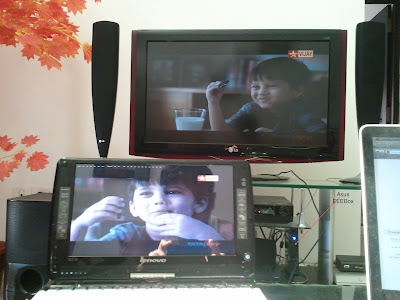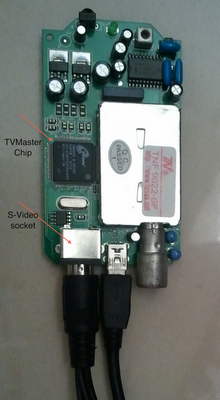Last weekend, I managed to complete a long-pending project of mine. The idea was to setup an infrastructure at home so I could watch TV from anywhere in my home (ie., network streaming via Wifi). I missed this facility particularly when we have guests at home and we couldn't watch TV at our convenience (second TV? No, there are differences and I don't need a second one right now).
Bottom line is, I now can watch TV anywhere in my house -- on my laptop, even on my mobile!! See this lenovo touch tablet showing Oreo Ad on Vijay TV:

I had always felt that I have everything I needed to do this, but it has not been that easy before I discovered all the right things. A simple way to put it would be: connect the video/audio output of the set-top-box to a TV tuner on a comp and stream it! But a number of questions need to be answered at every stage in this setup.
1. Video Output of Set-Top-Box:
I needed a video output that is in parallel to the one that connected to my TV. I don't want to plug out and plug in every time I need to stream TV content. Fortunately, I have been using the component video of the STB for my TV due to its greater clarity, so the composite video was idling anyways. Cool.
2. Audio Output of Set-Top-Box:
I had to use a splitter here, as the stereo audio output is connected to my home theatre already.
3. Connect it to the TV tuner:
It is this stage that took me a while to figure out!! I had a TV tuner that I used and hacked long back. When it looked like everything was in place, I realized that the TV tuner only has a S-Video input and a RF antenna (cable) input. I would need a composite input socket and there is no easy conversion possible from composite to S-Video (ie., pin to pin mapping) due to the difference in the signals. I opened the TV tuner box and searched for any composite video input that probably didn't get exposed outside -- hoping I could solder them if required. This is the TV tuner motherboard:


Could not find any socket/pin for composite video. I found the TV tuner chip on the motherboard ie., Trident TVMaster. On downloading the datasheet of the chip, I could confirm that the chip in deed supports Composite video as input. The pin diagram in the datasheet had clear indication of I/O pins available for composite input. When I traced those lines from the chip on the motherboard, it ended up in the existing S-Video socket. This kind of contradicts! How could S-Video port provide a composite input?! After lots of reading, the conclusion was simple : my TV tuner uses a non-standard 9 pin S-Video socket (while a standard S-Video socket is just 4 pins -- Y, C, Gnd, Gnd). The 9-pin socket is compatible with the 4-pin S-video socket, so the remaining 5 pins could be used for other inputs. Some hardware (like my TV Tuner) use this for simplicity in its form-factor. So all I needed was a conversion cable from composite video to 9-pin S-Video -- note: this is just pin mapping, no real signal conversion. Fortunately got this simple cable from ebay. I had reached this point months back and the project stalled :D
4. TV tuner works?
I had used this TV tuner against RF cable earlier, but never used/tested with composite video; and given all these conversion thingy, I wanted to first test if the TV tuner software works directly. And, yes it did!! I just had to configure the software to use the correct input signal. But TV tuner software doesn't stream, it just renders locally.
5. Stream it from VLC:
TV tuner device creates a video device on the computer and the tuner software uses the same. My tuner creates a Video device called 'Trident Analog Video'. VLC supports playing/streaming of video devices via DirectShow. I had streamed webcam's earlier, so wasn't anything new here for me. Things that required attention was how to configure via VLC, to use the correct input (Composite) -- as this device supports multiple inputs (RF antenna, S-Video, Composite etc). VLC has 'advanced options' while streaming that lets us configure the device. Input signal had to be set as '1' for composite. Used 'avi' as the container, 'divx' as video codec, 'aac' as audio codec. I have a Asus EEEBox on my setup that is already connected to the TV for other usage. Due to its proximity to the set-top-box, I used my eeebox for this purpose too. It connects to my home network via Wifi, so it could be reached from anywhere in my house.
6. Play it from VLC:
Now that the stream is on, all I need to do is connect to it via network. I used VLC again from a Lenovo touch tablet and connected to the eeebox via Wifi. Voila! I could now watch TV on my laptop. I'm yet to figure out an app for Android that could show multimedia stream over network -- given the small screen size, I am not that keen on watching TV on mobile. And as it has to go through the whole process of capture/encode/stream/network/decode/render, there is a delay of few seconds against the video on the live TV.
Some of you might have already thought about this: the only missing thing is that I can't change channels remotely. But it is just because I don't have a network remote, yet! (I have been eye-ing on Logitech Harmony Link for sometime :D).
Bottom line is, I now can watch TV anywhere in my house -- on my laptop, even on my mobile!! See this lenovo touch tablet showing Oreo Ad on Vijay TV:

I had always felt that I have everything I needed to do this, but it has not been that easy before I discovered all the right things. A simple way to put it would be: connect the video/audio output of the set-top-box to a TV tuner on a comp and stream it! But a number of questions need to be answered at every stage in this setup.
1. Video Output of Set-Top-Box:
I needed a video output that is in parallel to the one that connected to my TV. I don't want to plug out and plug in every time I need to stream TV content. Fortunately, I have been using the component video of the STB for my TV due to its greater clarity, so the composite video was idling anyways. Cool.
2. Audio Output of Set-Top-Box:
I had to use a splitter here, as the stereo audio output is connected to my home theatre already.
3. Connect it to the TV tuner:
It is this stage that took me a while to figure out!! I had a TV tuner that I used and hacked long back. When it looked like everything was in place, I realized that the TV tuner only has a S-Video input and a RF antenna (cable) input. I would need a composite input socket and there is no easy conversion possible from composite to S-Video (ie., pin to pin mapping) due to the difference in the signals. I opened the TV tuner box and searched for any composite video input that probably didn't get exposed outside -- hoping I could solder them if required. This is the TV tuner motherboard:


Could not find any socket/pin for composite video. I found the TV tuner chip on the motherboard ie., Trident TVMaster. On downloading the datasheet of the chip, I could confirm that the chip in deed supports Composite video as input. The pin diagram in the datasheet had clear indication of I/O pins available for composite input. When I traced those lines from the chip on the motherboard, it ended up in the existing S-Video socket. This kind of contradicts! How could S-Video port provide a composite input?! After lots of reading, the conclusion was simple : my TV tuner uses a non-standard 9 pin S-Video socket (while a standard S-Video socket is just 4 pins -- Y, C, Gnd, Gnd). The 9-pin socket is compatible with the 4-pin S-video socket, so the remaining 5 pins could be used for other inputs. Some hardware (like my TV Tuner) use this for simplicity in its form-factor. So all I needed was a conversion cable from composite video to 9-pin S-Video -- note: this is just pin mapping, no real signal conversion. Fortunately got this simple cable from ebay. I had reached this point months back and the project stalled :D
4. TV tuner works?
I had used this TV tuner against RF cable earlier, but never used/tested with composite video; and given all these conversion thingy, I wanted to first test if the TV tuner software works directly. And, yes it did!! I just had to configure the software to use the correct input signal. But TV tuner software doesn't stream, it just renders locally.
5. Stream it from VLC:
TV tuner device creates a video device on the computer and the tuner software uses the same. My tuner creates a Video device called 'Trident Analog Video'. VLC supports playing/streaming of video devices via DirectShow. I had streamed webcam's earlier, so wasn't anything new here for me. Things that required attention was how to configure via VLC, to use the correct input (Composite) -- as this device supports multiple inputs (RF antenna, S-Video, Composite etc). VLC has 'advanced options' while streaming that lets us configure the device. Input signal had to be set as '1' for composite. Used 'avi' as the container, 'divx' as video codec, 'aac' as audio codec. I have a Asus EEEBox on my setup that is already connected to the TV for other usage. Due to its proximity to the set-top-box, I used my eeebox for this purpose too. It connects to my home network via Wifi, so it could be reached from anywhere in my house.
6. Play it from VLC:
Now that the stream is on, all I need to do is connect to it via network. I used VLC again from a Lenovo touch tablet and connected to the eeebox via Wifi. Voila! I could now watch TV on my laptop. I'm yet to figure out an app for Android that could show multimedia stream over network -- given the small screen size, I am not that keen on watching TV on mobile. And as it has to go through the whole process of capture/encode/stream/network/decode/render, there is a delay of few seconds against the video on the live TV.
Some of you might have already thought about this: the only missing thing is that I can't change channels remotely. But it is just because I don't have a network remote, yet! (I have been eye-ing on Logitech Harmony Link for sometime :D).
